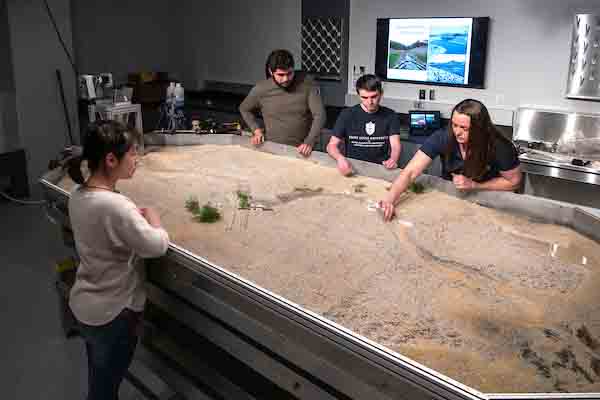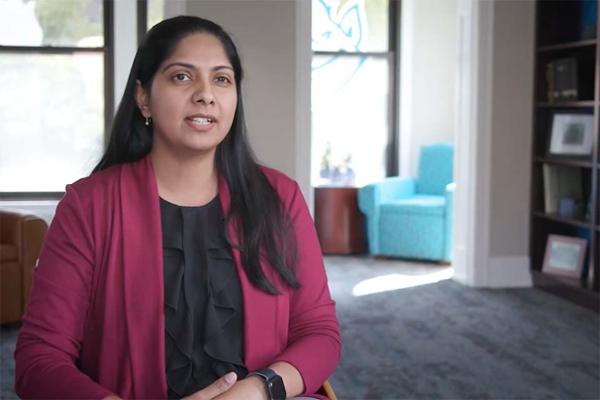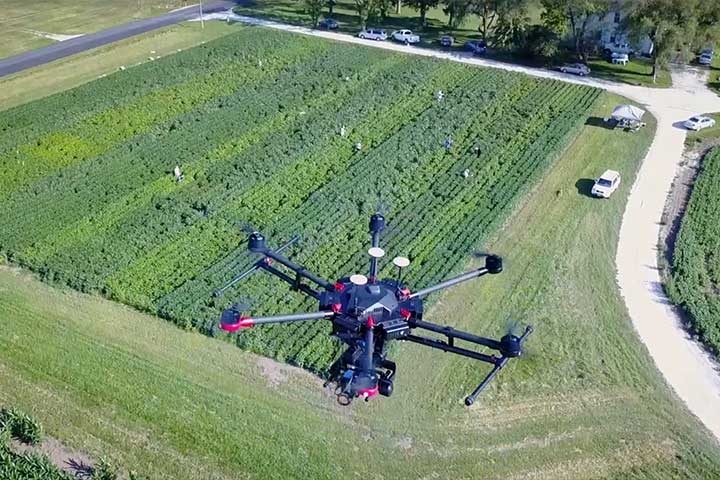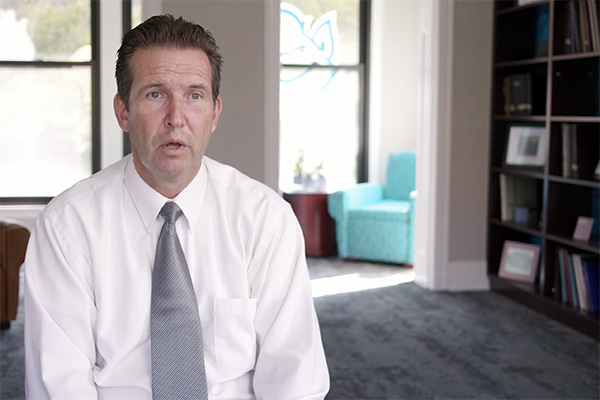Students at Saint Louis University School for Science and Engineering have the opportunity to apply their education in a global context.
Our research areas cross traditional disciplines, allowing students to work with internal and external faculty. Both undergraduate and graduate students collaborate with faculty, publish their results and present at professional conferences.
We design our research projects to help students find ways to be technically brilliant, socially responsible, and enterprising, and ultimately make our world better.
Students can participate in research in a number of ways, through coursework, informal lab assistance, as graduate research assistants, and through thesis or dissertation work.
Areas of Research
Unmanned Aerial Systems and Flight Control Systems
Research on flight control systems for UAS focuses on the development of resource-aware fault-tolerant algorithms and their evaluation through flight testing on UAS. The goal of this program is to ensure the safe flight of aerial systems, under various abnormal flight conditions. Active research includes landmark (vision) based navigation, Virtual/Augmented reality and Natural Language-based interactions with drones, Machine Learning, as well as Artificial Intelligence/Machine Learning for UAS. This could involve simulating damaged aircraft to test fault tolerance, or simulating atmospheric conditions of Uranus and Neptune to examine possible aircraft designs for flight missions on outer planets. Research in UAS and Flight Control Systems is an integral part of the AI @ SLU Big Idea Initiative.
Learn more about the AirCRAFT Lab.
Faculty: Srikanth Gururajan, Ph.D., Sanjay Jayaram, Ph.D., Ray LeBeau, Ph.D., and Kyle Mitchell, Ph.D.
Space Systems
Modern electronics and modern delivery systems have enabled the use of very small spacecraft to achieve important science, exploration and technology demonstration missions. However, these new kinds of spacecraft face new obstacles to achieving mission success. At SLU, space systems research focuses on three areas: mission assurance of small spacecraft, development of new components for small spacecraft, and flight experiments in spacecraft autonomy.
Learn more about the Space Systems Research Laboratory and CubeSat Mission Database.
Faculty: Sanjay Jayaram, Ph.D. and Michael Swartwout, Ph.D.
Engineering Education
Engineering education is an interdisciplinary field that includes collaborations between experts in engineering, education and psychology. Research in engineering education goes beyond improvements to engineering teaching by focusing on how people learn engineering and how to measure learning. Such research is well guided by specific research questions and hypotheses and ranges from engineering in K-through-12 to various topics related to undergraduate and graduate education and even industry applications. The current focus of Parks College is K-through-12 engineering education, which includes improving STEM pathways, math and science readiness, and engineering self-efficacy, along with the effects of experiential learning, service-learning, and collaborative learning on student retention and success at the college level. Parks has collaborations and funded work in this area with St. Louis Public Schools, KEEN, and Boeing.
Faculty: Jenna Gorlewicz, Ph.D.
Innovation and Entrepreneurship
To be an entrepreneur, students must possess four major aspects: technical competency, an understanding of customer needs, a sense of business and societal values. At Parks, we are not only creating curricular innovations to encourage our students to become entrepreneurs, but we are researching exciting facets of engineering entrepreneurship and entrepreneurship education. We are educating engineers to have the entrepreneurial spirit coupled with a strong business sense, forming future leaders with the technical and business knowledge to make an impact on the world.
Faculty: Sridhar Condoor, Ph.D., Jenna Gorlewicz, Ph.D. and Andrew Hall, Ph.D.
Biomaterials
A biomaterial is any substance that has been engineered to interact with biological systems in a medical application, either therapeutic or diagnostic. The field of biomaterials is multidisciplinary encompassing elements of medicine, biology, chemistry, tissue engineering and materials science. Our biomaterials research is multifaceted, including designing and synthesizing novel biomaterials, designing technologies for biomaterials fabrication, biomaterials characterization and specific applications. Recent research has focused on hydrogel biomaterials for drug delivery and drug screening applications.
Visit the Zustiak Soft Tissue Engineering Laboratory for more details.
Faculty: Gary Bledsoe, Ph.D., Koyal Garg, Ph.D., Scott Sell, Ph.D., and Silviya Zustiak, Ph.D.
Haptic and Human-Machine Interfaces
SLU researchers in this area seek to promote effective human-machine interaction, particularly in education, medicine and consumer technologies. We are creating and building the next generation of interfaces that will convey information multimodally and effectively to enable humans and novel technologies to work seamlessly and efficiently together.
We are particularly interested in the role of haptics (touch feedback) in enhancing these new interactions and promoting new levels of information transfer that currently aren’t possible. Examples of projects in this area of research include designing next generation surface haptic touchscreens; automatic, multimodal evaluation of neurologic function; and creating multimodal learning experiences in STEM for students with blindness and low vision.
Learn more about the CHROME Lab.
Faculty: Yan Gai, Ph.D., Jenna Gorlewicz, Ph.D..
Solid and Fluid Biomechanics
Biomechanics is the study of force, motion and strength (mechanics) applied to biological cells, tissues, organs and systems. Understanding how mechanics are applied to and affect living systems is the purview of biomechanics. From the study of how sports injuries occur and how bones break to that of cardiac muscle cell responses to force, all represent important biomechanics questions.
The most advanced cardiovascular flow emulator in the world is used to model healthy and diseased conditions in the human cardiovascular system, including the effects on the four chambers of the heart, coronary, cerebral, renal and peripheral perfusion. The effect of various prosthetic and assist devices is modeled experimentally and numerically. Current developments are in the definition of non-dimensional fluid mechanic hemocompatibility parameters. In addition to studying blood flow simulation in high shear, computation fluid dynamic simulations are being done on patient-specific models of pharyngeal airways, nasal airways, and aortic valve anatomies built from computer tomography (CT) scans, plus a few modeled valve geometries.
Faculty: Theodosios Alexander, Sc.D., Gary Bledsoe, Ph.D., Natasha Case, Ph.D., Andrew Hall, Ph.D. and Mark McQuilling, Ph.D.
Tissue Engineering and Regenerative Medicine
Tissue engineering and regenerative medicine are rapidly growing, interdisciplinary fields that apply the principles and innovations of engineering and the life sciences to the development and restoration of tissues and organs. While similar, the two fields are often separated by their unique approaches. Tissue engineering is often identified by its aim to create tissue equivalents through a combination of tissue templates and scaffolds, mammalian cells and signaling systems. Regenerative medicine often utilizes the body’s own reparative capacity, enhanced through the application and manipulation of stem cells and growth factors, coupled with advanced rehabilitative technologies to restore tissue function. Typical targets for tissue engineering and regenerative medicine include skin, bone, muscle, cartilage, nerve, and other organs that necessitate repair and replacement. Other research involves musculoskeletal tissue engineering and rehabilitation, such as developing therapies for bone fracture healing and muscle regeneration following volumetric muscle loss. In terms of rehabilitation, electrical stimulation as a new approach to physical therapy following skeletal muscle injury and ultrasound-based therapy for the healing of bone fractures is also being investigated.
Visit the Musculoskeletal Tissue Engineering Laboratory for more details.
Faculty: Gary Bledsoe, Ph.D., Natasha Case, Ph.D., Koyal Garg, Ph.D., Scott Sell, Ph.D., and Silviya Zustiak, Ph.D.
Fluid Dynamics
Fluid dynamics research at Parks includes a wide variety of applications and speed ranges using both experimental and computational methods. Current projects include studying the planetary atmospheres of Uranus and Neptune, aerodynamics and design of low Reynolds number airfoils for wings and turbines, high-speed shock wave-boundary layer interactions, and transonic linear turbine cascades.
Experimental facilities available for use include: a low-speed subsonic wind tunnel capable of air speeds up to 150mph with a 28" tall X 40" wide test section with optically clear side walls and top; a low-speed subsonic wind tunnel capable of air speeds up to 100mph with a 12" tall X 12" wide test section with optically clear side walls; a supersonic wind tunnel capable of Mach numbers up to 3.5 with a 5" tall X 5" wide test section having optically clear side walls; and a polysonic reconfigurable wind tunnel capable of high subsonic, transonic, and supersonic test conditions which can accommodate straight and curved flow path test sections.
Available measurement instrumentation includes a six-component pyramidal balance underneath the test section of the larger subsonic wind tunnel; pressure measurement equipment for low-speed and high-speed testing; thermocouples for temperature measurement; a two-dimensional particle image velocimetry system for velocity measurement in low-speed flows; a two-dimensional thermal anemometry system for velocity measurement; and a standard schlieren system for imaging compressible flow features.
Faculty: Ray LeBeau, Ph.D. and Mark McQuilling, Ph.D.
Infrastructure
This research area includes sophisticated analytical behavior and modeling of infrastructures, such as buildings and bridges under static, cyclic and extreme loading. It also includes damage modeling and experimental testing under cyclic and static loading, confinement of reinforced concrete elements, low-cycle fatigue, and behavior of bridges under vehicular live load. Our research team has extensive experience with bridge and structural monitoring and field instrumentation. The focus is to conduct meaningful and applied research that leads to successful implementation to state and federal agencies standards.
Faculty: Riyadh Hindi, Ph.D., and Ronaldo Luna, Ph.D.
Manufacturing and Materials
In Advanced Manufacturing, people use advanced technology to improve the manufactured products or manufacturing processes. This research area includes numerical and experimental investigation of machining (turning, milling, drilling, EDM, and welding) of difficult-to-machine materials, numerical and experimental investigation of laser peening processes of advanced materials, micro-machining and nano-machining of brittle materials and metallic materials, laser-assisted machining of brittle materials, nanosecond/femtosecond laser-matter interaction, robotics/mechatronics, monitoring and testing of manufacturing processes/failure of mechanical systems, automation of manufacturing processes using PLC and Industrial Robots, CAD/CAM.
Multifunctional materials are novel materials that couple multiple physical orderings. Examples include shape memory alloys, ferroelectric materials, ferromagnetic materials, thermoelectric materials and lithium ion batteries. These materials have motivated potential applications in actuators, sensors, energy harvesting, data storage, energy storage, micro-devices, among others. The macroscopic behaviors are determined by the underlying microstructures under specific physical and geometric compatibilities. Multi-scale simulations with molecular dynamics, phase field and finite elements are developed to investigate structure-property relations across multiple length and time scales, from which new materials can be designed computationally. Insights are provided for experiments, fabrications and applications.
The experimental facilities include Manufacturing System Laboratory, Mechatronics Laboratory, and Laser Peening Laboratory. Computer simulations are supported by supercomputing servers.
Aviation Safety
Safety is a process by which hazards are identified and their associated risks are understood. Good safety refers to the minimization of hazards or the comprehensive mitigation of risks. Perfect safety is improbable and impossible, as all activities involve a degree of risk. Consequently, organizations that are generally considered safe work proactively to seek out hazards and reduce their probability of operationalizing into an incident or accident.
Faculty: Terrence Kelly, Ph.D. and Gajapriya Tamilselvan, Ph.D.
Human Factors and Physiology
Human factors is the study of the interface in complex systems between the human and all other constituents. Influenced by human and system capabilities and associated limitations, human factors research at Parks College examines how the boundaries between humans and systems are simplified for ease of use and improved reliability. While maintaining the elements of more traditional human physiology human factors, researchers at Parks College focus on the interface of the human in the context of organizational relationships, and both their subtle and overt influence on safety culture.
Faculty: Stephen Belt, Ph.D., Terrence Kelly, Ph.D. and Gajapriya Tamilselvan, Ph.D.
Transportation
The transportation engineering research program focuses on improving the safety and mobility of the surface transportation system for all road users and modes of transportation. Statistical analysis, computer simulation, and predictive modeling are used to improve the design and operation of transportation facilities. The goal of this program is to contribute to transportation agencies’ efforts to provide a resilient, reliable, accessible, and equitable transportation system.
Faculty: Jalil Kianfar, Ph.D. and Ronaldo Luna, Ph.D.
Hydrodynamics and Environmental Fluid Mechanics
SLU hydrodynamics research solves complex problems associated with environmental fluid mechanics and many aspects of open-channel hydraulics for natural and engineered systems. Research areas include river engineering, hydraulic structures, sediment transport, urban drainage and stormwater erosion. These research efforts also help understand how hydrodynamic processes affect water quality and ecosystems. Physical and numerical hydraulic modeling is the primary research methods and researchers incorporate several state-of-the-art technologies, such as computation fluid dynamics (CFD), particle image velocimetry (PIV), remote sensing, and acoustic Doppler current profiling (ADCP) techniques.
Visit the Hydraulic Engineering Research site for more details.
Faculty: Amanda Cox, Ph.D.
The WATER Institute
WATER Institute faculty investigators conduct interdisciplinary research that addresses critical water resource challenges while strengthening existing efforts across the University. The research conducted at the WATER Institute focuses primarily on three critical areas:
- Addressing water-related social justice issues at home and around the world
- Protecting aquatic ecosystems
- Improving infrastructure to secure water supplies and address key societal needs
Learn more about the WATER Institute
Faculty: Amanda Cox, Ph.D.
Water Quality and Treatment
SLU environmental engineering research focuses on developing sustainable solutions to water quality and treatment issues facing the region and nation. The research approach used within this area is to use fundamental principles and methods including kinetic modeling, to solve highly applied environmental engineering problems. Research often addresses the analysis, occurrence and treatment of emerging contaminants, such as cyanotoxins, pharmaceuticals, disinfection byproducts and related compounds.
The Water Quality and Treatment Laboratory is used to conduct research on oxidation (e.g., chlorine, ozone and permanganate) and sorption (e.g., powdered activated carbon, activated alumina) processes. Applications focus on drinking water sources and treatment, but also include saltwater aquaria and wastewater treatment processes. A major focus of this research thrust is the development, testing and implementation of point-of-use treatment technologies for use in developing nations.
Faculty: Amanda Cox, Ph.D.



